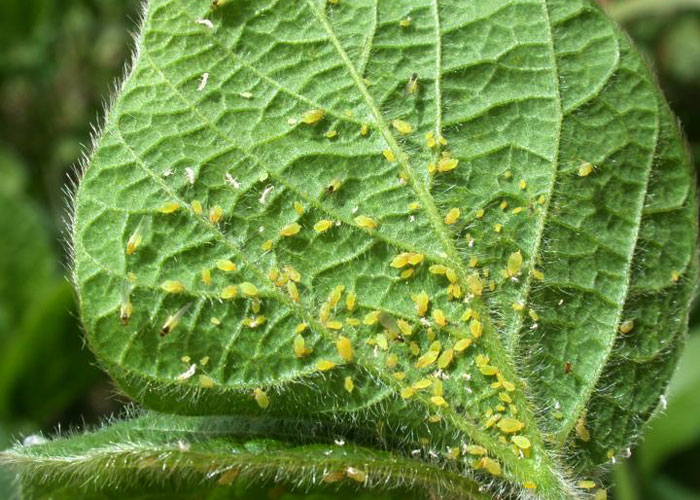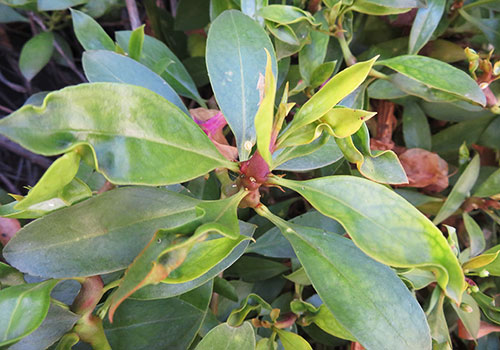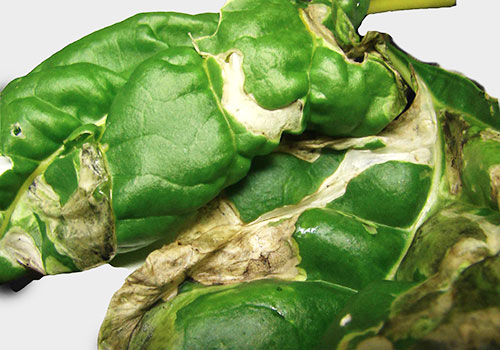Pest Damage ID Part 2: Who’s Discoloring My Leaves?
Pest damage isn’t always as obvious as holes in your leaves. In our last pest damage ID post, we covered the most common insect pests that chew or rasp away at plant leaves. This time, we’re taking a look at some more subtle culprits: those that suck the juices right out of your plants like little insect vampires, or even tunnel right through them.
If your plants are suffering from discoloration, failure to thrive, or they just have a weird appearance, you might be dealing with one of the critters we’ll cover here. Read on to find out who might be messing with your plant’s good looks, and what you can do about it.
But first: is it even a pest?
There are lots of reasons why a plant might fail to thrive or have a funky look about it, and insects with sucking mouthparts are just one option. Gardeners often think they are dealing with a pest when the problem actually lies in environmental factors like nutrients, sunlight, and water. In fact, the most common answer we give to pest questions here at Sky may well be, “It’s not a pest at all!”
Sometimes, it’s obvious that pests are present, because you can see them on your plants. If that’s the case, just check to make sure that they aren’t actually beneficial insects or creatures that don’t necessarily deserve their bad reputation before you decide to engage them in battle. Sometimes it turns out that plant damage is actually unrelated to any insects you might see on or around your plants!
If you aren’t sure whether the damage is caused by pests, go through this checklist before you go looking for a creature culprit:
- Have you chosen the right plant for the right place, planted, and watered correctly by following our planting guide?
- For annual flowers and vegetables, did you plant them at the right time?
- Have you added plenty of organic matter to support the plant you’re growing?
- Is your soil at the right level of acidity?
- Do your plants have the right amount of balanced, organic fertilizer?
By the way, even if your issue is a pest, providing the right conditions for your plant still forms the foundation of dealing with the problem. Happy plants are often very good at warding off pests all by themselves!
Occasionally, your issue may actually be a microbial or viral disease, rather than an animal. If all of the above seem on track but you’re seeing an overall “weird look” to your entire plant rather than damage to specific areas, your plant may be sick. Typically, the best thing you can do in that case is go back to the list above to make sure you’re providing the best possible overall care, and think good thoughts about your plant’s natural ability to fight off disease. But do come check with us about it, because there are things you can do to mitigate some diseases, such as the ubiquitous powdery mildew.
Once you’ve ruled out environmental problems and disease, you’re ready to identify your pest.

Aphids
Has any gardener ever made it through a full season without encountering aphids? If so, we’d like to hear about it, and possibly give them a medal. If you see large clusters of tiny black, green, or fuzzy white blobs all over the stems and leaves of your plants, you’ll know it’s your turn to deal with these amazing yet obnoxious pests.
Aphids are slow-moving and basically defenseless, yet they can cause gardeners a lot of trouble. They use their syringe-like mouthparts to suck the sap out of your plants, in some cases inadvertently transmitting plant diseases. If left unchecked, a large colony of aphids can weaken and kill a plant in pretty short order.
Aphids have two big tricks up their little buggy sleeves.
The first is cloning. Female aphids pop out as many of a dozen genetic copies of themselves per day, without having to mate, and these babies arrive already crawling around and ready to feast upon your plants. Even worse, they can come out pregnant with their own little clones. That means a single aphid can turn into hundreds of aphids in a matter of days.
Their second trick is even wilder: aphids are often under the protection of ants. Ants farm aphids much the way humans farm dairy animals. The “milk” ants are after is the sugary honeydew that aphids secrete as they suck all the good stuff out of your plants. Ants will pick up their livestock to move them to fresh pasture, and they have even been known to clip aphid’s wings to prevent them from flying away. They will also defend their herds by fighting off predatory insects and eating their eggs.
The good news about aphids is that LOTS of predatory insects would like to eat them. Keep an eye out for adult ladybugs and their alligator-like black and red larvae, hovering yellow and black syrphid flies, large predatory wasps patrolling the surfaces of your leaves, and the “mummified” hulls of aphids that are the calling card of tiny parasitic wasps. These are a few of your best allies.
While syrphid fly larvae are voracious predators, the adults eat nectar. You can attract them by planting their favorite ornamental flowers such as yarrow and calendula, and by letting your parsley, cilantro, and overwintered carrots flower. Ladybugs and wasps are attracted by the aphids themselves. If you have faith in your garden ecosystem and you are able to check your plants frequently, you might even purposefully leave a small population of aphids alone for a few days to see if these predators arrive on the scene before the colony gets out of control.
But if you have a large infestation or few predators, or ants are fending off all your allies, you may need to take matters into your own hands. The safest and most environmentally friendly spray that works on aphids is biodegradable soap. You can buy a commercial mix such as the Safer® brand, or make your own by mixing one tablespoon of natural castile soap such as Dr. Bronner’s® with a quart of water. Soap only kills insects it touches, so it won’t have any lingering impacts on the environment, and it won’t harm your plants. Of course, this also means you need to spray thoroughly, covering all the surfaces of your plants and as many aphids as you can, for the treatment to be effective.
Thrips
If you have excellent eyesight and you watch your plants very attentively, you just might see a thrip. These extra-teensy creatures look like fast-moving bits of embroidery thread. But the chances are that you’ll see the damage they cause before you see them. Stippled leaves, strangely misshapen flowers, and twisted-looking leaves and stems can all be signs of thrips. Various kinds of thrips can attack all kinds of plants, including edibles, annuals, perennials, and trees and shrubs.
Unfortunately, doing battle directly with thrips tends to be a losing proposition. They may even be long gone by the time you notice the damage, since they tend to attack developing tissue and it’s hard to see the impacts until the plant matures. Even if you do catch them while they’re present, it’s hard to have much impact on thrips with anything except the most toxic of pesticides. It’s also worth noting that not all thrips are pests! There are predatory thrips that actually eat pests, so wiping out every thrip in your garden isn’t a great idea.
For all of those reasons, your best defense against thrips is prevention. If you have had an issue with thrips in a certain area before, take extra care to remove debris and as many weeds as possible from the area. That will help limit their overwintering habitat. Some people also have success with reflective mulches such as straw or aluminum foil, which seem to make it harder for thrips to find their host plants. For annuals and edibles, you can use floating row cover to keep thrips out in the spring.
Thrips also have plenty of natural enemies, including predatory mites, ladybugs, and parasitic wasps. So you might do well to build a healthy ecosystem full of diverse flowering plants that will help attract the enemy of your enemies.
If you have a confirmed, heavy infestation of thrips and you decide that pesticides are necessary, try a biodegradable soap solution first. If that doesn’t work, try pyrethrins or neem oil. If the affected plant is not in bloom and none of the other solutions are working. It tends to be more effective on thrips than other organic pesticides, but that’s because it’s more toxic. It penetrates a little way into the plant and persists for about a week. This helps it work against those sneaky, tiny thrips, but also poses a threat to pollinators and other beneficial insects.
Leafhoppers
These slender little winged insects are often quite pretty, since they tend to sport colorful accents on their grasshopper-like green or brown bodies. They can fly, but usually prefer to jump away when you disturb them.
West coast leafhoppers can cause stippling, but usually don’t cause significant damage directly from feeding. The biggest cause for concern with these sucking insects is that they can transmit plant diseases. There’s no need to panic when you see one though. As long as your plants are healthy and you use sound practices to limit the leafhopper population in your garden, the chances of your plants getting sick from any particular bug are pretty low.
Luckily, many of the same natural methods that keep populations of other pests down also work on leafhoppers. Unless you find yourself with a huge population boom, there is probably no need to bother trying to treat them with any kind of spray.
Adults lay eggs in the spring. They prefer moderate weather, and are less active in the heat of summer. Covering plants with a light cover such as remay is a good way to keep them out while they are most active and your plants are most vulnerable. Once the plants outgrow the cover, the bugs will be less active and your plants will also have more of their own defenses.
During the growing season, the same predatory insects that help with many other pests will also eat the eggs and larvae of leaf hoppers. Make sure to grow diverse pollen and nectar plants to attract them.
It is difficult to treat them with anything but the most toxic pesticides. All of the least toxic options only work on contact, and leafhoppers are unlikely to stand still long enough to get coated with neem oil or soap. Again, prevention is your best bet.
Leaf Miners
While the other pests on this list all suck the juices out of your plants, leaf miners cause their own special kind of mayhem. These tiny fly larvae tunnel through the leaves of your plants, literally between the layers of leaf tissue. If you see transparent “windows” or winding trails through the middle of your leaves, you have leaf miners. They especially love spinach, chard (pictured above), and beets, but they can show up on a variety of other edible and ornamental plants as well.
Contact pesticides do not work well on leaf miners, since they have their surrounding plant tissue to protect them. The best and safest methods for controlling leaf miners are prevention and mechanical control (which is a fancy term for “squish them”).
The yearly leaf miner cycle starts with adult flies emerging from the soil in the early spring. They will lay their tiny eggs on your leaves, and the larvae will tunnel inside when they hatch. Once larvae have eaten their fill, they will drop down into the soil for their pupa phase before emerging again as adults ready to lay more eggs. This whole process only takes a few weeks, so leaf miners can quickly multiply over the course of a single growing season if left unchecked.
Covering your plants with re-may or another lightweight cover when you plant in the spring is a great way to stop the cycle before it starts. Adult flies could always make their way to your place from a neighbor’s later in the season, but at least you’ll prevent your garden’s population from getting an early start.
Once the season is underway and your plants are uncovered, keep an eye out for those windows and tunnels in your leaves. As soon as you spot one, it’s time for that fancy mechanical control technique. Here are some step by step instructions:
- Extend your thumb and forefinger while curling your other fingers in, as in the ASL sign for the letter “G.”
- Position your hand such that your thumb is on one side of the tunnel or window and your forefinger is on the other.
- Pinch your fingers together firmly.
- Repeat if necessary to cover the entire affected area.
Alternatively, you could remove entire affected leaves and dispose of them in your green municipal compost bin. This might be a good method if only a few leaves are affected but they have a lot of tunnels.
The Big Picture
It’s always good to know which pest you’re dealing with so that you can respond in a precise and effective way. But try not to get too fixated on eradicating every single pest in sight. It's a fact of nature: healthy garden ecosystems include herbivores; otherwise, what would all those lovely ladybugs eat? Pest problems can be frustrating, but they can also be great opportunities to learn more about your garden and keep improving the overall health of its ecosystem, year after year.


